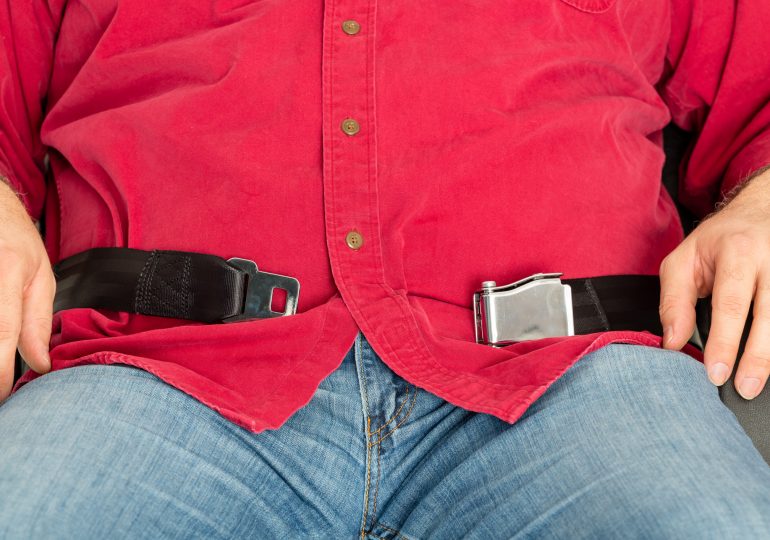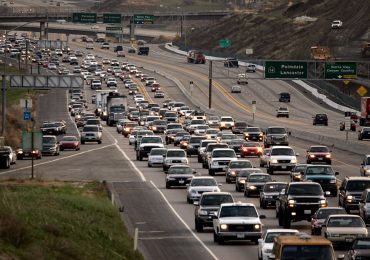“Hi, I’m hoping to use your customer-of-size policy today,” a woman says to an Southwest Airlines gate agent before being handed a complimentary second ticket for the adjacent seat on the flight she was boarding, in a now-viral TikTok video. The post, which has racked up more than 900,000 views since it was first shared in October, has sparked strong, mixed reactions about the ways in which plus-sized travelers are—or aren’t—accommodated in the air.
[time-brightcove not-tgx=”true”]
Some have praised Southwest’s approach as “amazing,” while others have criticized the airline for “rewarding obesity.”
Southwest’s customer-of-size policy isn’t new, but the renewed attention brought to it in recent weeks reflects the increasing relevance of airlines’ plus-sized-passenger rules—especially as Americans on average continue to grow larger, while airplane seats have allegedly become smaller.
Since the 1960s, the number of obese people in the U.S. aged 20 and above have increased from just 10% of the population to some 42% by 2020, according to the Centers for Disease Control and Prevention. Meanwhile, advocates claim that airplane seat widths have decreased by as much as 3 inches over the last three decades.
Read More: More Than Half of the World Will Be Obese By 2035
Often, the onus of figuring out how to manage the incongruity is put on customers, whose options are limited and often result in frustration for both the passenger whose seat is too small as well as their neighbors who may feel encroached upon.
Jae’lynn Chaney, a plus-sized traveler and influencer, launched a petition earlier this year asking the Federal Aviation Administration to require all airlines to implement a clear and comprehensive customer-of-size policy.
For now, most airlines simply recommend requesting a seatbelt extender, purchasing an additional seat, or upgrading to a higher fare class that offers more personal space.
Tigress Osborn, executive director of the National Association to Advance Fat Acceptance, told CNBC in August that plus-sized people also often face calls to simply avoid air travel, which she describes as unreasonable.
“Fat people deserve to travel for pleasure just like everyone else, and we also need to remember that air travel is for work, for family obligations, and for other responsibilities, too,” she said. “Our taxes help support this industry, and we deserve to be accommodated safely and comfortably, with access to accessible seating at all price levels.”
Here is the current guidance U.S. airlines offer for passengers who exceed size restrictions.
Alaska Airlines
According to its website, Alaska Airlines requires the purchase of an additional seat for any customer “who cannot comfortably seat with the armrests in the down position.” The width between Alaska Airlines’ armrests is 17 inches for economy seating and 21 inches for first class.
Alaska recommends booking the extra seat ahead of time. “If a second seat has not been purchased, you’ll be asked to purchase an additional seat before boarding the aircraft,” it says.
If the flight departed with an open seat available, the passenger is eligible to request a refund for their second seat.
Allegiant Air
With a seat width of 17.8 inches, passengers who either are unable to lower the armrests or compromise any portion of adjacent seats “should purchase an additional ticket” during reservation, Allegiant Air’s website says. Two adjacent seats will then be pre-assigned—at no additional cost.
If an extra seat was not pre-booked, on the date of travel, a “passenger of size” may only be able to purchase a second ticket if two adjacent seats are still available. “In the event the flight is sold out and an extra seat is unavailable, the passenger of size shall be denied travel in the interest of safety.”
American Airlines
“If a customer needs extra space outside a single seat to travel safely, another seat is required,” American Airlines’ website says. Like other airlines, it recommends reserving the extra seat during the initial booking.
“If you didn’t book an extra seat in advance,” the guidance says, “you may be offered a seat in a higher class of service that may provide more space; in this case, you’ll be responsible for the fare difference. If accommodations can’t be made on your original flight, you can buy seats on a different flight at the same price as your original seats.”
Delta Airlines
Delta Airlines’ economy seats are 17.2 inches in width and have 31-32 inches of legroom. Seatbelt extenders can be provided upon request in-flight, but personal seatbelt extenders are barred.
“For customers who need extra space,” Delta says on its website, “you can ask to be reseated next to an empty seat or pay to upgrade to First/Business class. To ensure your comfort, you might consider booking an additional seat.”
Frontier Airlines
Frontier Airlines’ website simply says that passengers unable to lower the armrests should book two seats prior to travel. “The armrest is considered to be the definitive boundary between seats,” it says.
Hawaiian Airlines
Most seats on Hawaiian Airlines’ airplanes are 18 inches wide, according to its website, which breaks down the seat size on the various aircraft it operates.
“If you are unable to sit comfortably in your seat with the armrests lowered, we will try to find a suitable alternative,” guidelines on Hawaiian Airlines’ website say, recommending booking an extra seat in advance and calling their hotlines to ensure the seats are adjacent. “However, if no safe alternative seating can be found, we may not be able to transport you on your ticketed flight.”
JetBlue
JetBlue does not appear to have any specific policy for plus-sized passengers and did not respond to a request for comment from TIME. Flyers can purchase extra seats for themselves, and passengers can request seatbelt extenders in-flight, according to the website Portly Passengers, which is one of several sites that offer travel tips for plus-sized passengers.
Southwest Airlines
According to Southwest’s website, customers who encroach upon any part of the neighboring seat, as demarcated by the armrests, “may proactively purchase the needed number of seats prior to travel” to ensure availability. “The purchase of additional seats serves as a notification of a special seating need and allows us to adequately plan for the number of occupied seats onboard,” the policy states, emphasizing that the airline will “refund all extra seat purchases for a Customer of size, even if the flight oversells.”
“If you prefer not to purchase an additional seat in advance, you have the option of purchasing just one seat and then discussing your seating needs with the Customer Service Agent at the departure gate. If it’s determined that a second (or third) seat is needed, you’ll be accommodated with a complimentary additional seat.”
Spirit Airlines
Spirit Airlines says on its website that “a guest of size who encroaches on an adjacent seat area and/or is unable to sit in a single seat with the armrests lowered” is required to purchase an extra seat.
United Airlines
According to United’s website, if a passenger cannot buckle their seatbelt, takes up space in adjacent seats, or cannot keep their armrests lowered while they are seated, they must buy an extra seat.
“If an extra seat isn’t available, you’ll need to change your flight to one that has extra seats. If you’re not in your home city, state, or country, and your new flight requires you to stay overnight,” the guidance also stipulates, “we can give you meal and hotel vouchers as well.”
Leave a comment
















